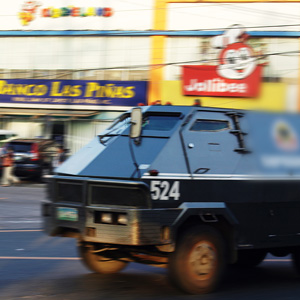Today’s armored car services have definitely seen an improvement over the security situation compared to the 1990s when armored car robberies were more rampant. The changes this industry has seen in terms of the quality of armored vehicles and the training of the personnel escorting it has proven to be effective given developments in recent years. The banking sector’s proactive approach in security has helped deter if not totally minimize robberies while cash is in transit. Compared to the past year, the rate of bank robbery holdups in the country has been lower by at least 30%. With only a recorded 16 cases so far this year, the numbers are down from the 24 reported bank robberies in 2008.
Aside from commercial and rural banks as primary targets, robberies while cash in is transit has been a recognized opportunity for bank robbers. Which is why the emphasis on trusted armor services is now being highlighted as a crucial part of bank security management, with some banks establishing their own in-house fleet, while majority of other banks opt to outsource through the handful of armor service providers in the country.
The most critical period during armored operations is during loading and unloading of cash. This is when the highest likelihood that perpetrators will strike. “When we talk of pick-ups from one branch to another, the bank security can be there to assist the armored personnel in securing the area. The problem we are facing now is picking up deposits from clients, particularly inside malls or public places where the environment is undetermined. This makes it hard to establish suspicious persons or vehicles in the area because the study of the environment is not that fixed. Unlike inside a branch wherein we can easily determine if there are suspicious persons,” Victor Valdez, Corporate Security Manager of Allied Bank, says.
Cases where an armored vehicle is assaulted while in transit are very rare due to the level of difficulty. “If the criminals do not seize the window of opportunity during loading or unloading, then that will mean the vehicle will already be locked and bullets cannot penetrate inside,” says Valdez. The only specification for the fabrication of armored vehicles released by the Bangko Sentral ng Pilipinas (BSP) is that it should be bullet-proof from M-16 and M-14 rifles. Most armored cars are made from imported parts but are customized and designed locally. There are very few armored service providers in the country because of the high cost of maintenance for these vehicles. An armored vehicle costs more than P1M.
Despite these security procedures, sometimes the impermeable quality of an armored vehicle is not enough to assure total security of the funds. Stringent hiring processes are also key in preventing robberies, especially in cases where the crime has been perpetrated by the security guards themselves. Such was the case of Security Bank in 2008 wherein an armored car was about to deliver P80M from their head office to the BSP. The vehicle made a stop wherein the escorts and the driver had gone down. The robbers ended up commandeering the vehicle, which was later found abandoned at a parking lot. “Although this was a case involving negligence on the part of the driver, there have been cases like what happened in Metrobank in Davao where the robbery was an inside job,” says Valdez.
Although a bank with its own private armored services has its advantages, it can also prove to be more expensive. “Based on our study, it is more economical to rent rather than to own our own security in terms of administrative and operational problems,” Valdez admits. This holds true in cases when a unit breaks down. If it is bank-owned, given the limited number of vehicles, there may not be a ready replacement. Whereas if it is outsourced, the service provider is obliged to replace the unit immediately when it breaks down. The problem that arises since most armored cars are leased by the company is that the bank usually leaves the operations to the service provider, which includes the selection of the guards. “The selection of the guards is the part which is mostly neglected. However, there is a provision wherein if a bank is into lease and the perpetrators are the guards themselves or if the guards are in cahoots with the robbers, then their agency is liable for whatever loss the bank incurs,” Valdez says. So the biggest upside in having in-house security is that it allows the bank to better monitor its own people. “It’s always better to have your own guard force because of the loyalty of the recruits and the control over the process of recruitment. When you are outsourcing, you leave the process of recruitment to the service provider. However, there are banks like Allied Bank that will still opt to screen all the security guards deployed to them by the service provider. So before they are posted to a branch or an armored vehicle they have to report first to us for an interview and must submit all documents and clearances from pertinent government agencies,” Valdez explains.
RCBC Cabuyao incident
One of the biggest eye-openers in the importance of bank security management happened last year. In what seemed like a vicious and senseless killing, 10 people ended up dead during a bank robbery at the Cabuyao, Laguna branch of Rizal Commercial Banking Corporation on May 16, 2008. This was a unique robbery case because of the nature of what happened. It was the only incident in the country where all of the hostages were killed. And given that the robbers still left a substantial amount in the bank and the victims (which included eight bank employees, a security guard and a bank representative) were all killed execution-style, the cause of the killings remains inconclusive. News of the robbery shocked the local and even international banking community because of the gruesome and senseless deaths. Members of robbery groups will say that they have no intention of killing when committing a robbery. They would only be determined to kill if their lives are put in danger. This is why bank employees are advised to just obey the robber’s orders so they will not be harmed. “In the case of RCBC in terms of fatalities, it is extraordinary. There are incidents wherein the commando approach of the robbers involved people getting shot, but in RCBC where all the employees were shot fatally in the head, it was really meant to silence and kill the witnesses. Although we know we cannot avoid robberies, we can try to mitigate the cost of impact. Our number one consideration is that no lives should be involved. No casualties and as much as possible, no injuries. Secondly, if a bank is being robbed, the amount involved should be at the least, minimum. So aside from the physical security, we are also implementing some measures in coordination with the operations of the bank like the installation of time-delay locks, which is a mandate of the BSP,” Valdez explains. With most commando-type robberies usually lasting only a maximum of three minutes, a time-delay lock will deter the possibility of getting away with a bigger amount.
Specific security training
As anyone in the banking industry knows, the threat of robbery is a glaring reality. It is an accepted risk that one takes when working in a bank. Security officers are very much aware that robbers now go through painstaking preparations before committing a robbery. It may even take them up to half a year just to study the movement in the bank, identify the peak period of the pick-up and study the number of security personnel involved. The number of robbers, compared to bank security personnel, has also gone up, with some gangs having 15 to 30 members, depending on the difficulty of the heist. Robbers also look at two key aspects of a robbery: the difficulty of the mission and the amount of cash involved. They will conduct painstaking research on bank operations, with some robbers even posing as bank clients and setting up a relationship with the bank long before committing the robbery.
With criminals now using different ways to pull off a heist, the bank security management industry has also had to step up and change its approach by taking more proactive measures to prevent these kinds of incidents. One of these steps starts during training of security personnel. Banks now have separate training for guards for bank premises and armored escorts. Plus, all security personnel servicing banks have approved training regulations called the Comprehensive Bank and Armored Security Training Program. “We integrate the training, considering that the function of the armored crew is complemented by the function of the premises guard and vice-versa,” shares Valdez.
Police back-up
Banks have also taken it upon themselves to communicate with each other when it comes to security issues and concerns, hence the formation of the Bank Security Management Association of the Philippines (BSMA), which is a 50-bank membership strong organization represented by all the chief security officers of commercial banks, rural banks and thrift banks. Coordination with the police has also become very important for bank security. With the Joint Anti-Bank Robbery Action Committee (JABRAC), bank security officers meet quarterly at Camp Crame with the Philippine National Police (PNP) hierarchy, the Armored Services Association of the Philippines (ASAP), Metro Manila Development Authority (MMDA), the police districts of Metro Manila and police provincial units to exchange views and best practices and discuss important issues.
BSP’s emphasis on armored vehicles
According to the BSP circular, banks are not allowed to engage in transfer of funds or cash without using an armored vehicle. The vehicle should also be manned by at least two armed escorts, not counting the driver and a teller. It is a violation if the armored car does pick-ups without any bank representative. The pick-up should also be supervised by at least two officers of the bank. The only time the BSP allows the use of non-armored vehicle is during emergency or unforeseen cases wherein a bank has need for immediate pick-up and all armored cars have already been dispatched. It can also only be done within a five-kilometer radius, otherwise an armored vehicle is already required. The amount involved should also be adequately insured and the strictest measures of security should be adopted.
Future of armored security in the Philippines
As a bank progresses, so does its security operations. The BSP once had plans to have centralized control over the pick-ups of armored vehicles, but this plan has yet to materialize because of budget and operational constraints. “This wasn’t carried out because even though the procedures in each bank are covered by the operations manual mandated by the BSP, the operations of each bank are still unique and it would also come out very costly for the BSP as they would also be outsourcing the armored vehicles,” Valdez says. •






